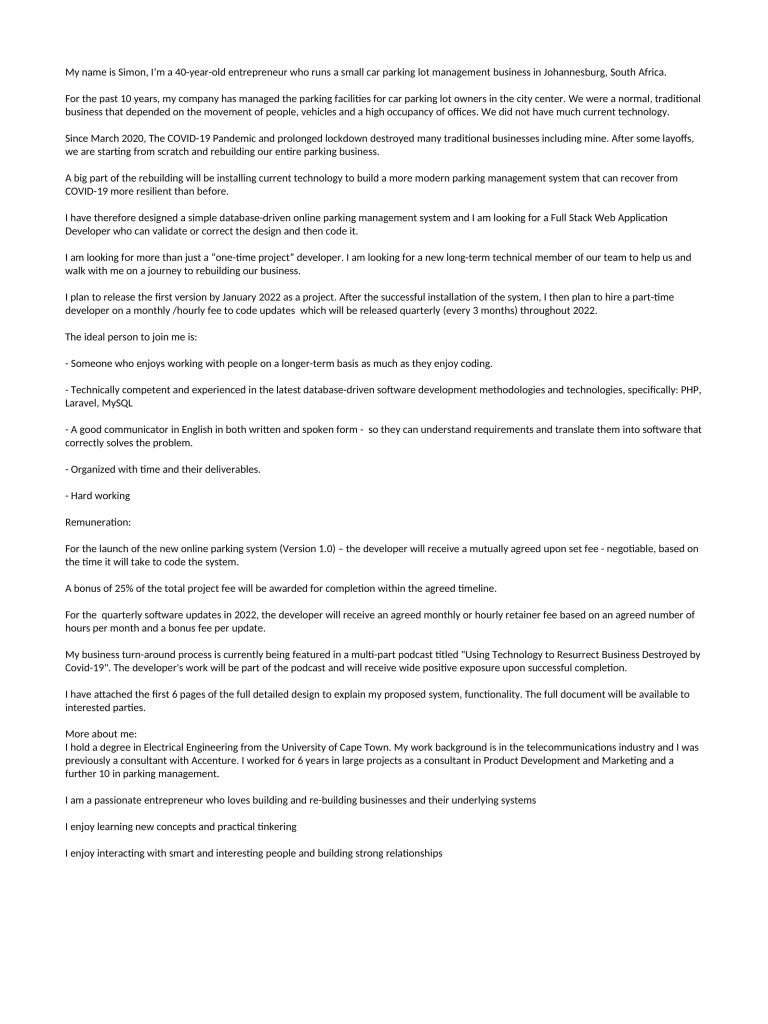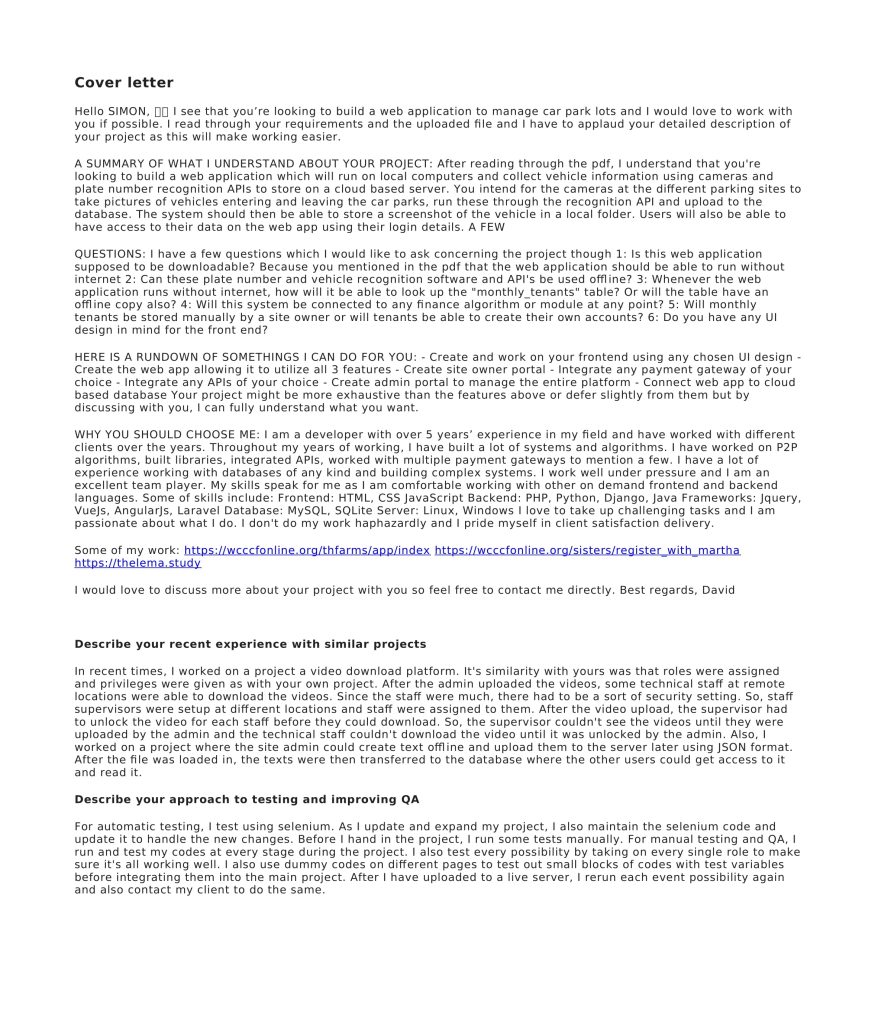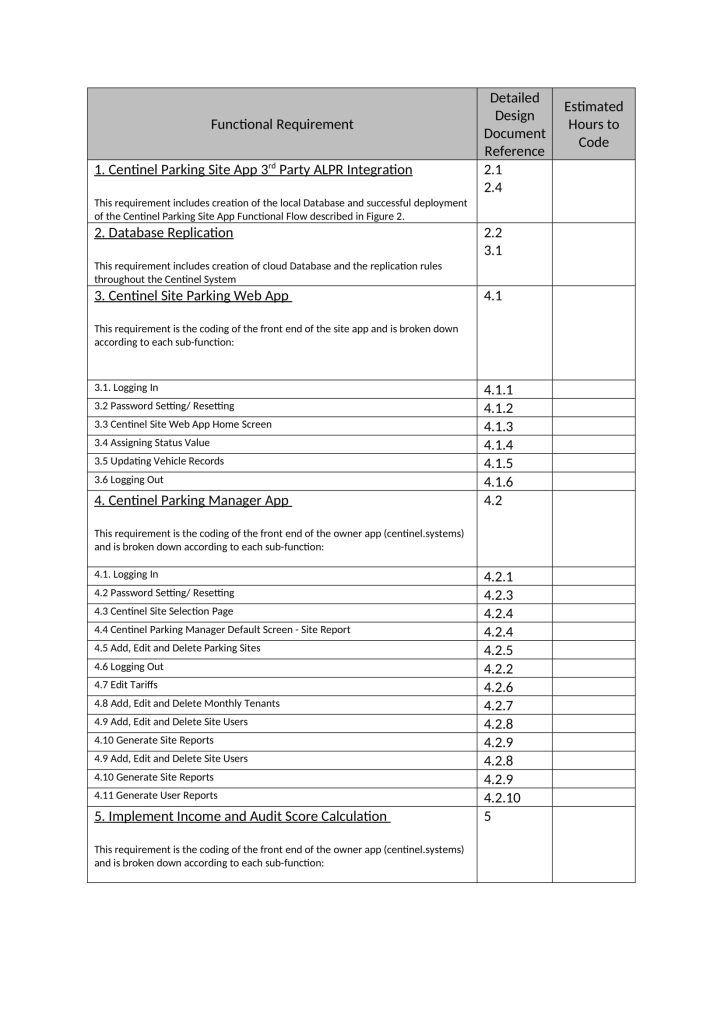Episode Timeline
Welcome back to Technorection, this is part 2 of our recording on the hiring process for Centinel.
We now have a simple design based on an already established core technology that took over double the scheduled time to complete but, it got us to our tech talent.
What are the keys to success in hiring online tech talent?
Two things enabled the hiring. Firstly, as I already detailed, the availability of core technology … simplified the design significantly, eliminating the need to have any senior specialized tech skills in parking technology. All we needed was generic web and database skills, which as you’ll soon see significantly reduces the costs of development because all we ended up needing was a single junior coder and not a highly expensive senior technology professional/s. It was a bit like getting a pre-done, simple plan for a self-build house, which eliminates the need for a fancy architect or superstar builder who’d probably need to create something bespoke from scratch.
The second key thing … and main thing that really blew me away was the discovery of established international marketplaces to find technical skills. A marketplace. like any other marketplace that may trade goods or commodities. These markets of course don’t sell Fresh produce, gold or oil, these marketplaces sell skills or services – anything from graphic design to drawing blueprints of physical products or 3d printing plans and of course skills in database-centric software coding, which is the exact skill we need to build Centinel. These talent marketplaces or freelance platforms are of course online and let millions of freelancers create a profile, list their available skills and charge rates to clients from all over the world.
The Freelance Platforms
The three that I have had experience with are Fivver, Freelancer and Upwork. Some platforms I have found are better than others for certain types of services – for example I think Fivver tends to attract a lot of graphic design and more relatively inexpensive services – hence the name… whereas Upwork tends to have more software development services or product design services. There are also different platforms for bigger projects and budgets for lager businesses, which are generally much more expensive – platforms like Toptal.
So why use freelance platforms to find talent and not the regular recruitment process? – Well, this is Technorection a podcast that is all about using technology to rebuild a small defunct old-world businesses, using traditional old-world recruitment does not make sense. Recruitment is typically local and typically fussy for the smaller business with limited resources.
I can attest that during the strongest periods of our growth, we spent more time with HR and hiring than other critical processes for a young small business like in for sales or operations. An online, no-middleman, international, recruiting platform with millions of potential hires in one place saves not just a ton of time and money but, you may not even find the skills at all in your location at any price, so availability itself is a benefit.
These international platforms highlight a reality of the modern world: The importance of Global Trade. They’re freelancers and clients like me from all countries on Earth. So, if you order a service on the platform, it’s the equivalent of importing a product from their country into yours. You are participating in international trade where money flows out of your country and services are delivered to you from another.
It’s quite cool to think that if you have a skill or talent (writing, design, support or ). that you can deliver online that you are actually an international trader of talent. Your base is the entire world.
These platforms can give you clues on which globally tradable skills are currently in demand and which are likely to be in the future, based on the services real customers are ordering today. This is a huge advantage in a challenging job market? To know where to put your eggs, vocationally and also knowing you can sell anywhere on earth. I would encourage anyone to see what’s out there, even if you are not looking to hire skills. It’s helpful seeing what is out there and perhaps finding out if your job is represented and how many people are offering the service.
The Talent Profiles and Your Brief
When you are ready to dive in and use the platforms, you’ll find they have a few things in common with dating apps like tinder. Instead of matching up potential lovebirds, they are connecting clients with freelancers. You search in various job categories where Freelances put up their profiles:
Their name, location, profile picture, English language level, brief description of themselves, qualifications, their available skills, hourly rates and importantly – overall ratings and completed projects with client feedback.
There is also a client area where I create a profile of myself and my business. In my profile, I will post the job or the brief – that is available publicly for freelancers to see. It’s Some background to the project, what I am looking for, my timeframe, the budget and a snippet of the design. The more thought that goes into a brief, the better the match will be between client and freelancer. Especially the budget. Setting it to low will put off potential hires, setting it too high reduces your runway to take off.
Your brief – allows potential hires to evaluate you just like their profile allows you to evaluate them… If the project meets their own requirements in terms of skills, budget and time availability, they can be shortlisted.
like a tinder profile – make yourself as attractive as possible, but also be accurate, especially in estimating the timeframe.
Hours Estimations
So how do you estimate how long it should take to build a new system?
Not an easy one to answer… So many factors.
I worked backwards from when I wanted to launch – a nice round January 2022 and also estimated forward based on assuming the hire will spend only about a third of their productive day on Centinel, since as a freelancer it may not be the only thing they are working on. This time estimate method came to 2 calendar months exactly or 120 man-hours @ 3hrs per day. These hours are then multiplied by the freelancer’s rate to get an idea of the total talent cost. So, I bounced this timeframe off David to make sure he agreed that it correlated with the design and it did not.
To correlate it simpler, we divided up the build into 5 parts and within each of those we divided into smaller component parts still. Each small component was then given a timeframe. E.g. like building the log-in function – a small component part was given 7 hours by David. Counting up all the component parts came to 192 hours. Quite a bit more than the initial 120. Now even though David agreed with the 192 hours, I added an extra 4 calendar week’s contingency and I also added an on-time bonus fee of 25% of the total project cost to motivate finishing on time.
Working for LESS Money
Now I need to mention that this approach actually priced the talent WAY higher than I could afford. David agreed, without negotiation to about a third of what the total fee should have been… Basically what I could afford… I’ll tell you why in a minute. Before matching up with David I sent our brief to about 10 developers and I received about 10 further proposals from developers in India, Ethiopia, Pakistan, Kenya, The Philippines, Nigeria and Indonesia. Of all the coders I sent our brief… Every single one rejected it. The price was just too low… I sent the brief to the belles of the ball…of course they were not interested – they are way out of my league.
The only shot I had was with the inbound proposals, but these candidates were not particularly… desirable because they have no documented experience on the platform. So therein lies the balance between price and perceived quality.
Good Online Hiring Advice
I found some tips from a YouTube channel called Time Doctor run by Rob Rawson.
According to him, you need to be sending out your brief to minimum of 20 and up to 100 candidates.
1. Be Specific
He advises to be specific about the technology that the coder should use to build your system. Specify the tech in the brief… This really is vital because specifying the exact tech will filter in more skilled candidates. If you’re not sure about the tech– then perhaps instead of hiring a coder, you should first do the research or hire a consultant on the platform to help with your pre-code brief and design.
2. Do Not Just Look at Ratings
Rob also says when evaluating candidates, do not go only for ratings. In fact, he thinks for longer term projects, you should ignore the ratings all together. This sounds risky, but actually seems reasonable. All the top-rated talent – the belles of the ball – they are too busy working on great jobs getting great reviews to be available to start work on our little project. They are in a position of choosing their projects…. And then you get the talented coders with very few or no reviews or ratings on the platform yet who may have a lot of experience off the platform. These are the best candidates for longer term lower cost projects because they are keen to build their profiles on the platform are just as talented as higher rated ones and are available immediately.
3. Hire More than One
Lastly, Rob advises hiring multiple coders at the same time. By breaking down your project and giving a tiny piece to multiple coders on a paid basis – you are able to evaluate them better than any interview can… you get to see how they actually work on a short, immediate project and also multiples hires doing the same project gives you insurance in case one bails out on you for whatever reason. This is probably the most difficult one for me to implement because it only works if you have the budget and in an international marketplace like Upwork, if often means that a client’s home currency must be much stronger than the freelancers’ home currency. Dollar, Pound, Euro based countries get way more for their bucks.
The Best Proposal
In the end, the proposal that towered above them all was David’s. Whilst everyone else was boasting about all the coding skills and they had and how they could deliver on time and why they were they best and even how easy the solution would be etc. etc. Whilst those candidates focused on themselves and their self-professed abilities, David’s response instead focused on the solution to the problem specified in the brief. He addressed every high-level problem that I outlined right there in his response, ensuring I knew that he understood the exact problem I want to solve and not just how great he was. He also addressed why he had so few reviews. He was brand new on the platform and wanted to gain experience with a long-term project. Exactly what Rob Rawson advised – just because they don’t have experience on the platform does not mean that they are not great coders.
I’ll attached both the brief and David’s response to the podcast notes for this recording:



Hours Estimation
Communication
So, if you are looking for a programmer to digitize your business or really for any skill, you can find a match on a freelancer platform like Upwork. Talent at all levels from all over the world. All you need is a project brief – this includes the design, the budget, timeframes your broad expectations of the candidate. Besides the freelancer’s competence and a detailed build plan, the most vital thing to ensure success… is the quality of the communication. I can’t state this enough but be sure to agree with the coder upfront on your style and expected frequency of communication. Whether phone or video calls, voice notes, email, text. You will often be working with someone outside of your time zone, so getting communication right is paramount.
The level or depth of communication will vary, don’t have to understand all the updates and coding issues that your coders gives you, but you have to receive the updates. You might find coders reluctant to spend time on sending you weekly updates especially when they are in the thick of the coding, but you need to insist on communicating consistently and regularly, even if to say they are struggling and have no real progress. They can send you screen shots of the error messages, or database structure. They can send you updates on screens they are implementing. Communication is as important as the work itself. Poor communication with a talented person is just as bad as great communication with an incompetent person and long lapses of silence can knock your confidence levels in the success of the entire project.
Speaking of confidence levels – i.e. how confident I feel that this project will succeed. I would say I’m at around 6/10 right now.
How do you see computer programmers?
I’m going to wrap up by asking the question – how do you see computer programmers?
If you, like us are using technology to modernize or totally rebuild your business, then you are really getting into the data business. No matter what business you are actually in, you are now also in the data business. Google is in the advertising business, but they are of course in the data business too. Same for Facebook or Amazon or any online retail business of which there are millions of unknowns. We are in the parking business… but Centinel will put us in the data business. If you are now in the data business – how do you see the computer programmers? The people building your digital home? How do you value what they do? If I’m building a dream house, I would place a huge value on the builders charged with its construction…They are building my dream one brick at a time…
So, the coders building your dream app – thrusting you and your business into the 2020s and beyond – are they merely dispensable hired help? Or are they vital and permanent members of your TEAM? I sincerely salute all coders from the small time and self-taught to the superstars who help build our amazing tech-rich lives, one line of code at a time…


